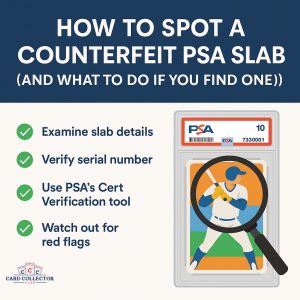When it comes to collectibles, especially high-value trading cards, trust in grading is everything. PSA (Professional Sports Authenticator) slabs are the gold standard in card authentication and grading, but with their popularity comes an unfortunate downside: counterfeits. In this guide, we’ll walk you through how to identify a fake PSA slab, how PSA’s tools can help verify authenticity, and what steps to take if you suspect a forgery.
Why Fake Slabs Exist

High-dollar cards, like graded rookie baseball cards or rare Pokémon holos, often command thousands of dollars at trading card auctions. As a result, counterfeiters have begun faking PSA slabs, attempting to replicate labels, casing, and even serial numbers to fool buyers.
In our experience as a PSA Authorized Dealer, these fake slabs are becoming more sophisticated, so even seasoned collectors need to stay vigilant.
How to Spot a Counterfeit PSA Slab
Here are six things every collector should examine before making a purchase:
1. Use the PSA Cert Verification Tool
Every authentic PSA card has a unique certification number printed on the label.
- Visit PSA’s Cert Verification Tool
- Enter the number exactly as it appears
- Ensure that the card details and grade match PSA’s database
If the cert doesn’t exist—or the image doesn’t match—it’s a red flag.
2. Inspect the Label Font & Spacing
Counterfeiters often struggle to match PSA’s precise font spacing and layout. Look for:
- Misaligned text
- Off-center printing
- Inconsistent font weights or colors
Compare side-by-side with another PSA slab if possible.
3. Check the PSA Logo & Hologram
PSA slabs feature:
- A PSA logo on the label and casing
- A holographic label or embedded strip for most modern slabs
Fakes often skip or poorly mimic these security features.
4. Feel the Case Quality
Authentic PSA slabs are made from crystal-clear, hard plastic with a sealed sonic weld.
- Fake cases may feel lighter or flimsier
- Look for gaps, glue, or uneven seams
If the slab feels “off,” trust your instincts.
5. Look for Label Tampering
Some counterfeiters use genuine PSA slabs but swap out the card or label.
- Confirm the card matches the certification
- Look for tamper evidence along the case edges
6. Avoid Too-Good-to-Be-True Deals
Scammers prey on urgency and lack of research. If the price seems unreal for a PSA 10, it probably is.
What To Do If You Suspect a Fake
If you believe a PSA slab is counterfeit:
- Do not buy it until you’ve verified its authenticity
- Report the card to PSA through their Fraudulent Slab Reporting Form
- Avoid sellers who won’t provide clear photos or cert numbers
If you already bought a fake, consult your payment provider for refund options and contact PSA to assist with documentation.
Trusted Ways to Buy and Grade
To reduce your risk of buying counterfeit slabs:
- Purchase from verified PSA dealers or sellers with strong reputation and feedback
- Use platforms with buyer protection policies
- Submit raw cards directly through trusted grading submission partners
At Card Collector Club, we streamline the process with secure submissions, graded resale, and autograph authentication under PSA’s standards.
Quick Checklist: Authenticating a PSA Slab
| Step | What to Check |
| 1 | Cert number matches PSA database |
| 2 | Label layout and font are clean and aligned |
| 3 | Hologram or embedded PSA security tag present |
| 4 | Case quality is hard, clear, and sonically sealed |
| 5 | Seller has a trustworthy history or verified badge |
| 6 | Price reflects real market value |
Final Thoughts
As the card market continues to grow, so does the importance of slab verification. Learning to identify fake PSA slabs is an essential skill for collectors of all levels.
By combining the right tools, experience, and a trusted network, you can protect your portfolio and enjoy the hobby with peace of mind.
Need help verifying a card or submitting your own collection for PSA card grading?
Reach out to Card Collector Club, your trusted PSA Authorized Dealer for grading, consignment, and authentication support.
